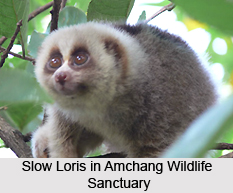 Amchang Wildlife Sanctuary is located in the in the eastern fringe of Guwahati city in Assam. The sanctuary covers an area of 78.64 sq. kms. Amchang wild life sanctuary is a perfect place for nature lovers to refresh themselves from the crowded city life. It is just 15 km from Guwahati Railway Station. On 19th June, 2004, the Assam Government declared this forest as a wild life sanctuary. It falls under East Kamrup Forest division.
Amchang Wildlife Sanctuary is located in the in the eastern fringe of Guwahati city in Assam. The sanctuary covers an area of 78.64 sq. kms. Amchang wild life sanctuary is a perfect place for nature lovers to refresh themselves from the crowded city life. It is just 15 km from Guwahati Railway Station. On 19th June, 2004, the Assam Government declared this forest as a wild life sanctuary. It falls under East Kamrup Forest division.
Flora and Fauna of Amchang Wildlife Sanctuary
The Amchang Wildlife Sanctuary houses a variety of animals, birds and reptiles that attract the attention of many tourists and nature lovers who come to visit the sanctuary from distant places. Common species of mammals generally seen in Amchang sanctuary are Chiness pangolin, Slow Loris, Flying Fox, Assamese macaque, Rhesus macaque, Capped langur, Hoolock gibbon, Jungle cat, leopard cat, leopard, Elephant, wild pig, sambar, Barking Deer, Porcupine, squirrel, Civet Cat and others. Python is a common species of reptiles found here. Indian cobra, Python and Monitor Lizard are also some reptile species which form a part of this forest ecosystem.
Amchang Wildlife Sanctuary also provides shelter to many domestic and migratory birds. As the Brahmaputra River is flowing adjacent to this forest, various species of birds take refuge here. Among them the most commonly seen species are Lesser Adjutant stork, Greater Adjutant Stork, white backed vulture; Slender billed Vulture, Khaleej Pheasant, Green Imperial Pigeon, Lessar Pied Hornbill, Parakeet and many others. The vegetation of this forest is mainly deciduous. Grass lands are also seen in some area
Presently due to continuous extension of city limits, the natural resource of this sanctuary is coming under great pressure. Thus the local people along with the Assam Forest Department and other government bodies extended their valuable support in safeguarding this natural heritage.
Amchang Wildlife Sanctuary is located close to Guwahati. There are many ways to reach the sanctuary from Guwahati. Guwahati Railway Station is just 15 km far. One can also enter from Sonapur side also. The road from Narengi through Bonda Forest office to Amchang WLS is the easiest route. The most suitable time to visit Amchang wildlife sanctuary is between the months of October to April.



















